Massachusetts is home to various birds, from woodpeckers to warblers to herons. The state boasts a unique mix of habitats, including beaches, marshes, woodlands, and grasslands, making it a bird haven.
With over 350 species of birds living in Massachusetts, it is a great place to observe and study birds. From the colorful Scarlet Tanager to the majestic Bald Eagle, there is something for everyone to enjoy.
Whether you are a beginner or an experienced birder, this guide to the birds of Massachusetts will help you identify, appreciate, and learn more about the avian species that call the Bay State home.
47 Birds Of Massachusetts
Massachusetts, known for its rich history, picturesque landscapes, and diverse ecosystems, is home to many bird species.
From the Berkshires’ lush forests to Cape Cod’s coastal marshes, this northeastern state offers habitats that attract various avian residents and migrants throughout the year.
Here are 47 Birds Of Massachusetts.
1. Black-Capped Chickadee
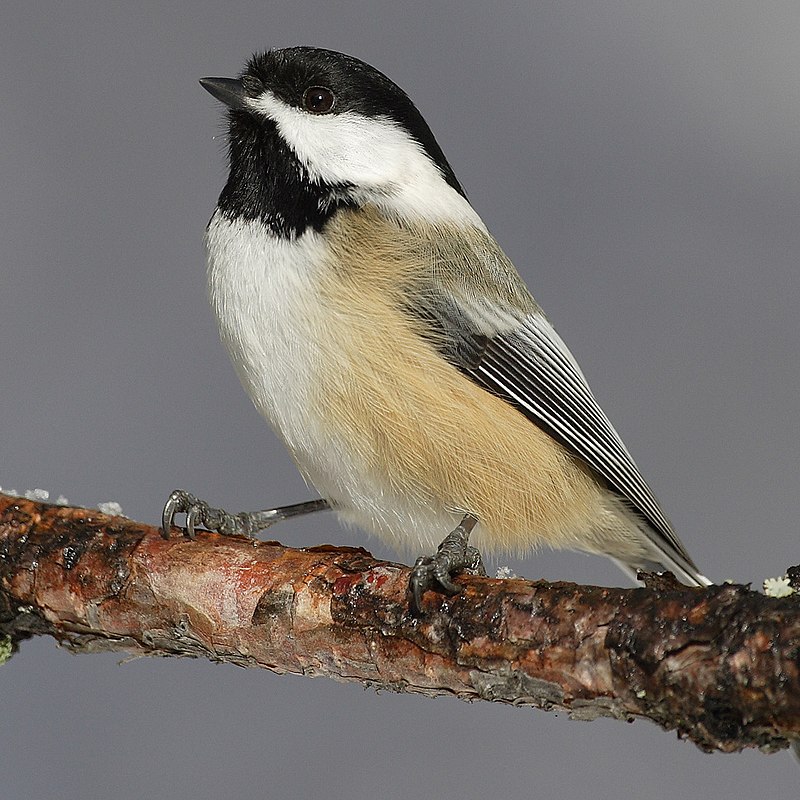
The black-capped chickadee is a small, cheerful songbird in deciduous and mixed forests across North America. It has an iconic black cap, white cheeks, gray back, and wings with whitish bars.
The underparts are usually light-colored or greyish-brown. This species is well adapted to cold winters as it can reduce its body temperature by up to 8°C while roosting at night; this helps save energy during the year’s colder months.
It feeds mainly on insects but eats seeds, fruits, and suet from bird feeders when available.
Black-capped chickadees are popular birds among backyard visitors due to their friendly nature – they often establish lifelong partnerships with one another for breeding purposes.
Furthermore, they have been designated as state birds of Massachusetts and Maine in the USA, plus New Brunswick in Canada – a testament to how beloved these little avian friends are.
Scientific classification:
| Kingdom | Animalia |
| Phylum | Chordata |
| Class | Aves |
| Order | Passeriformes |
| Family | Paridae |
| Genus | Poecile |
| Species | P. atricapillus |
2. American Goldfinch
The American goldfinch is a small North American bird in the finch family. Males are vibrant yellow with black wings and tails, while females are duller in coloration.
It migrates from mid-Alberta to North Carolina during the breeding season, south of Canada–United States border to Mexico for its wintering grounds.
The only finch that undergoes complete molt every year displays sexual dichromatism, where males have brighter colors than their female counterparts.
They feed mainly on seeds but also eat insects such as aphids and caterpillars when raising young; they often occur near thistles or other plants that produce viable seed heads.
Their call consists of various chirps and trills, making them quite conspicuous.
Scientific classification:
| Kingdom | Animalia |
| Phylum | Chordata |
| Class | Aves |
| Order | Passeriformes |
| Family | Fringillidae |
| Subfamily | Carduelinae |
| Genus | Spinus |
| Species | S. tristis |
3. Northern Cardinal
The Northern Cardinal is a beautiful bird, easily identified by its bright red plumage. It can be found in the eastern United States from Maine to Minnesota and south through Mexico and Belize.
Along with its striking coloration, it has a distinctive crest on its head and sharp black facial markings around the eyes.
Despite their small size (7-9 inches), they are very vocal birds – males sing persistently throughout springtime to attract mates or proclaim their territory.
They typically feed on insects, seeds, and fruits but enjoy suet at backyard bird feeders.
The female is less brightly colored than her mate but still stands out among other songbirds due to her warm brownish-red feathers.
Cardinals pair for life, so you may often see them together in your garden or neighborhood park.
Scientific classification:
| Kingdom | Animalia |
| Phylum | Chordata |
| Class | Aves |
| Order | Passeriformes |
| Family | Cardinalidae |
| Genus | C. cardinals |
| Species | C. cardinalis |
4. Mourning Dove
The Mourning Dove is a breathtakingly beautiful bird. It has stunning gray and brown feathers with white-tipped wings, giving it an elegant appearance. Its long tail also adds to its graceful look in flight.
A symbol of peace and serenity, they are abundant across North America and can be found in gardens or open fields throughout the year.
As well as being popular game birds for hunters, they feed on grains such as wheat and millet, providing essential food sources for wildlife species, including foxes, coyotes, skunks, and raccoons.
These doves have a distinctive cooing sound that can often echo through woodlands during summer evenings, making them one of nature’s greatest treasures.
Scientific classification:
| Kingdom | Animalia |
| Phylum | Chordata |
| Class | Aves |
| Order | Columbiformes |
| Family | Columbidae |
| Genus | Zenaida |
| Species | Z. macroura |
5. White-Breasted Nuthatch
The White-breasted Nuthatch is a medium-sized bird belonging to the nuthatch family Sittidae. It measures around 15.5 cm long, and its color varies throughout its range.
Males have a light blue-grey upperpart, with a black crown and nape, whereas females have a dark grey crown instead of a black one.
The underparts are whitish, with a reddish tinge on the sides and flanks, while the bill is short and stout with a pale base near the eyes, which can be yellow or white depending upon geographic location.
This species feeds mainly on insects but eats seeds, nuts, and berries when available.
They prefer open woodlands where they often climb trees searching for food along trunks and branches underneath bark crevices, creating their nest there, too.
Scientific classification:
| Kingdom | Animalia |
| Phylum | Chordata |
| Class | Aves |
| Order | Passeriformes |
| Family | Sittidae |
| Genus | Sitta |
| Species | S. carolinensis |
6. Blue Jay
The Blue Jay is a beautiful bird in the eastern and central United States and Newfoundland, Canada.
They have an unmistakable blue plumage with white markings on their heads and wings.
These birds are highly adaptable to habitats ranging from deciduous forests to urban areas.
As part of the Corvidae family, they are known for being intelligent problem solvers who often use tools or mimic vocalizations of other species, like hawks, when defending their territories.
Their diet consists mainly of insects, seeds, and nuts but can also include small vertebrates such as frogs or lizards if food resources become scarce.
Overall, these birds provide much-needed color to our environment while playing essential roles in maintaining healthy ecosystems through pollination services and seed dispersal activities.
Scientific classification:
| Kingdom | Animalia |
| Phylum | Chordata |
| Class | Aves |
| Order | Passeriformes |
| Family | Corvidae |
| Genus | Cyanocitta |
| Species | C. cristata |
7. Common Starling

The Common Starling is a medium-sized passerine bird that belongs to the Starling family. It has glossy black plumage with a metallic sheen and can be sprinkled with w at certain times.
The bill and legs are typically pink or black depending on the season, while its length measures about 8 inches long.
Its diet consists mainly of insects but includes small fruits, seeds, and human food waste.
They live in large flocks, which protects predators, although they can become quite aggressive when defending their nesting sites during breeding seasons.
Overall, this species is highly adaptable and widely distributed across many parts of Europe, making them one of the most successful birds in the region today.
Scientific classification:
| Kingdom | Animalia |
| Phylum | Chordata |
| Class | Aves |
| Order | Passeriformes |
| Family | Sturnidae |
| Genus | Sturnus |
| Species | S. vulgaris |
8. Downy Woodpecker
The downy woodpecker is a small species of woodpecker found in North America. Growing up to 7 inches long, it can be identified by its white belly and spotted wings.
It inhabits forests throughout the United States and Canada, except deserts in the southwest and northern tundra.
This bird nests in tree cavities and feeds mainly on insects but will supplement its diet with fruit or nuts when available.
The Downy Woodpecker has an unmistakable call that sounds like a loud ‘piker,’ similar to other members of its family, such as the Hairy Woodpecker.
Scientific classification:
| Kingdom | Animalia |
| Phylum | Chordata |
| Class | Aves |
| Order | Piciformes |
| Family | Picidae |
| Genus | Dryobates |
| Species | D. pubescens |
9. House Finch

The House Finch is a finch species native to western North America and has been introduced in the eastern half of the continent and Hawaii.
It’s an average-sized finch with adults measuring 12.5 – 15 cm (5 – 6 inches) long and a wingspan between 20 – 25 cm (8 – 10 inches).
The upperparts are brown, while its underparts range from pale grayish white to yellow depending on subspecies.
Its face is streaked or spotted with reddish coloration; males typically have brighter plumage than females due to sexual dimorphism.
They’re mostly found near human habitations such as farms and gardens, where they feed on grains, fruits, insects, etc., making them very popular among birders who want something colorful for their backyard.
Scientific classification:
| Kingdom | Animalia |
| Phylum | Chordata |
| Class | Aves |
| Order | Passeriformes |
| Family | Fringillidae |
| Subfamily | Carduelinae |
| Genus | Haemorhous |
| Species | H. mexicanus |
10. American Robin

The American robin is a migratory bird belonging to the valid thrush genus and Turdidae family.
It was named after its European counterpart due to the similar reddish-orange breast they possess; however, they are not closely related.
This species can be seen through most of North America during winter and in parts of Mexico and Central America, where it also breeds.
They have plump bodies with gray upperparts and white underparts that vary from yellow on their throats down to orange toward their bellies.
Robins feed on fruits such as berries or insects like worms, making them an essential part of ecosystems by helping disperse seeds naturally throughout these areas.
Scientific classification:
| Kingdom | Animalia |
| Phylum | Chordata |
| Class | Aves |
| Order | Passeriformes |
| Family | Turdidae |
| Genus | Turdus |
| Species | T. migratorius |
11. Tufted Titmouse
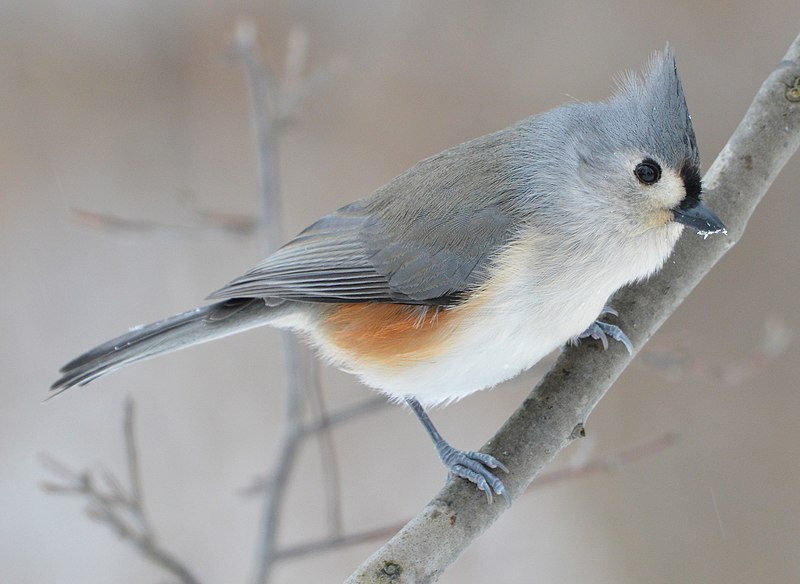
The Tufted Titmouse is a small, cheerful songbird found in North America. It’s part of the tit and chickadee family (Paridae).
It has distinctive white feathers around its eyes, grey-brown wings, and upper body, with a pale tan underside.
Its most notable feature is the black crest on top of its head, which gives it a curious look. The male also sports a pinkish breast, which can be seen.
When singing from high perches during the spring months. This bird loves to eat sunflower seeds or suet at backyard feeders and insects in summertime.
You may even see them poking into crevices and bark, looking for food.
They are exceptionally social birds, too, being often spotted in mixed flocks alongside other species, such as nuthatches and woodpeckers, all year round.
Scientific classification:
| Kingdom | Animalia |
| Phylum | Chordata |
| Class | Aves |
| Order | Passeriformes |
| Family | Paridae |
| Genus | Baeolophus |
| Species | B. bicolor |
12. Red-Winged Blackbird

The red-winged blackbird is a beautiful bird found in most of North America and Central America.
Its distinct features include a glossy black body, white shoulder patches, and bright red wing coverts year round.
It prefers wetland habitats such as marshes, ponds, lakeshores, and agricultural fields. During breeding season, they inhabit grassy areas near water, then move south for the winter months.
For food, they mainly eat insects but also consume wild fruit or grains.
They are very social birds, often seen in large flocks during migration when their unmistakable “conk-la-ree” call can be heard echoing across the sky.
Scientific classification:
| Kingdom | Animalia |
| Phylum | Chordata |
| Class | Aves |
| Order | Passeriformes |
| Family | Icteridae |
| Genus | Agelaius |
| Species | A. phoeniceus |
13. Dark-Eyed Junco

The Dark-eyed Junco is a species of small, grayish sparrows found across much of temperate North America and in the Arctic during summer.
Carl Linnaeus formally described it in 1766 and named it after its distinctive dark eyes.
This bird has a very variable appearance due to the many different subspecies it contains, making its systematics challenging to unravel.
The plumage varies from white or light gray on their underparts with slate grey backs and wings, black heads with white outer tail feathers, brown head stripes, yellow bills, pink legs and feet, and various shades between all these colors.
They also have considerable sexual dimorphism, where males tend to be more colorful than females but share similar characteristics such as short tails and rounded bodies – both sexes being around 16 cm long when fully grown.
Scientific classification:
| Kingdom | Animalia |
| Phylum | Chordata |
| Class | Aves |
| Order | Passeriformes |
| Family | Passerellidae |
| Genus | Junco |
| Species | J. hyemalis |
14. Common Grackle
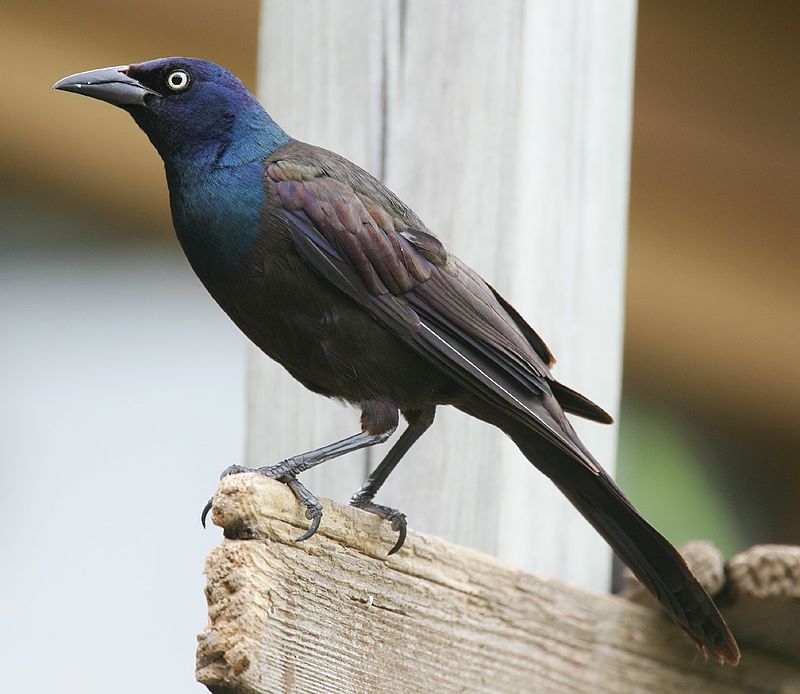
The Common Grackle is a large icterid bird commonly found in North America. It has an iridescent head and pale yellow eyes framed by its long dark bill and long tail.
Males typically have more vivid colors on their heads than females do. These birds can be seen across much of the continent, in fields, forests, wetlands – even urban areas.
They form considerable flocks to search for food, such as grains or insects, that they catch with their bills.
If available, the grackles may also scavenge from human sources like garbage dumps or picnic tables. With its colorful plumage and distinct call, spotting this species amongst other birds is easy.
Scientific classification:
| Kingdom | Animalia |
| Phylum | Chordata |
| Class | Aves |
| Order | Passeriformes |
| Family | Icteridae |
| Genus | Quiscalus |
| Species | Q. quiscula |
15. Song Sparrow
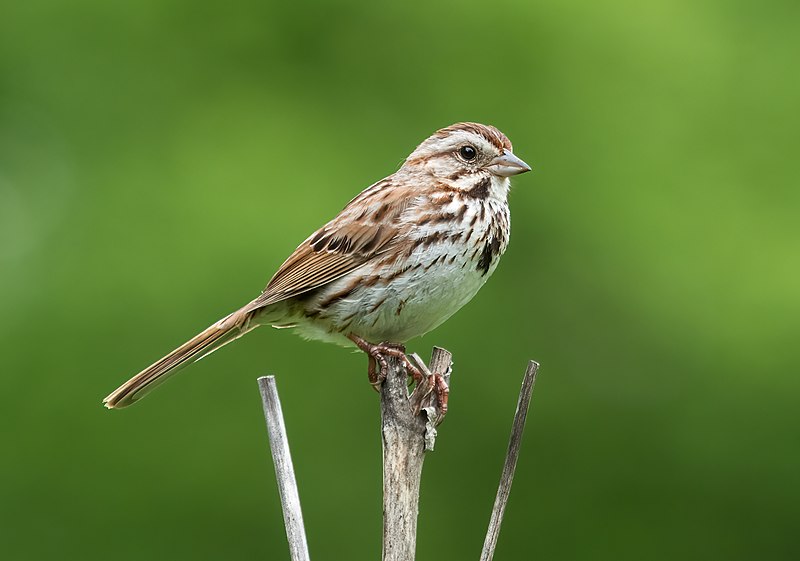
The Song Sparrow (Melospiza melodia) is a small yet abundant bird in North America.
They have brown upper parts with dark streaks and are white underneath, complete with a distinct dark brown spot on the breast.
Their cap is also brown, and long roughed feathers can be seen sprouting from their neck area.
This sparrow species is highly variable and adaptable to many environments, including dry brush land, wetlands, or open fields.
It has been noted that adult song sparrows will sing even during winter when other birds remain quiet.
These energetic little animals make great backyard companions as they sing their lovely melodies.
Scientific classification:
| Kingdom | Animalia |
| Phylum | Chordata |
| Class | Aves |
| Order | Passeriformes |
| Family | Passerellidae |
| Genus | Melospiza |
| Species | M. melodia |
16. Baltimore Oriole
The Baltimore Oriole is a small, blackbird-like bird in eastern North America. It’s named for the resemblance of its male colors to those on Lord Baltimore’s coat-of-arms from the 17th century.
These birds migrate and breed during springtime and are standard in their habitats.
Studies have shown that this species interbreeds with western Bullock’s orioles, classifying both as a single species – Icterus galbula.
The males typically have orange feathers along the chest, back, wings, and tail, while females display tan or yellowish shades instead of bright orange-like males.
Both sexes share white wing bars and dark brown eyes, making them easily distinguishable from other birds.
They can often be seen flitting around trees, feeding off nectar buds or insects such as grasshoppers & caterpillars they catch while flying around.
Scientific classification:
| Kingdom | Animalia |
| Phylum | Chordata |
| Class | Aves |
| Order | Passeriformes |
| Family | Icteridae |
| Genus | Icterus |
| Species | I. galbula |
17. Eastern Bluebird
The Eastern bluebird is a small migratory thrush found in North America’s open woodlands, farms, and orchards.
The male has bright-blue breeding plumage, which makes it easily recognizable by birders.
It produces melodic songs such as Jeew, chair-wi, and Chili WEEW Widow.
This widespread species was declared the state bird of Missouri back in 1927 due to its beauty and charm.
In addition to being beautiful, these birds are also beneficial for farmers because they eat insects like grasshoppers and beetles, which damage crops.
They nest in cavities, so providing nesting boxes helps them thrive even more.
With their vibrant colors, sweet melodies, and helpful nature, it’s easy to see why the Eastern Bluebird is beloved worldwide.
Scientific classification:
| Kingdom | Animalia |
| Phylum | Chordata |
| Class | Aves |
| Order | Passeriformes |
| Family | Turdidae |
| Genus | Sialia |
| Species | S. sialis |
18. Northern Mockingbird
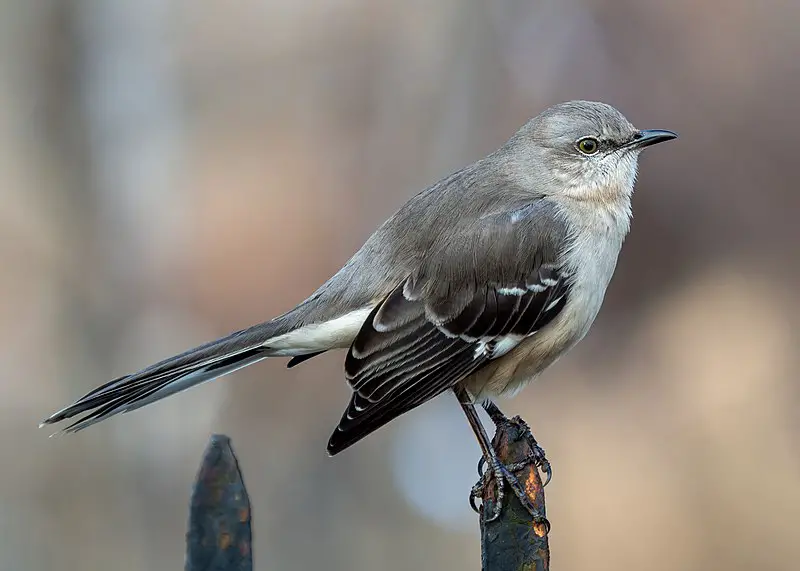
The northern mockingbird is a standard fixture in North American skies. It has greyish-brown upperparts and a paler underside with white wing patches, and its distinctive long tail makes it easy to spot.
This adaptable bird can often be seen singing from the tops of trees or fences, though it rarely strays into Europe.
Carl Linnaeus first described the species in his 1758 Systema Naturae as Turdus polyglottos – aptly named for their remarkable ability to mimic other birds’ songs.
Northern mockingbirds typically live on insects, fruits, berries, and seeds but will also happily scavenge food scraps left out by humans.
With its beautiful song and striking plumage, this beloved avian contributes to our environment.
Scientific classification:
| Kingdom | Animalia |
| Phylum | Chordata |
| Class | Aves |
| Order | Passeriformes |
| Family | Mimidae |
| Genus | Mimus |
| Species | M. polyglottos |
19. American Crow
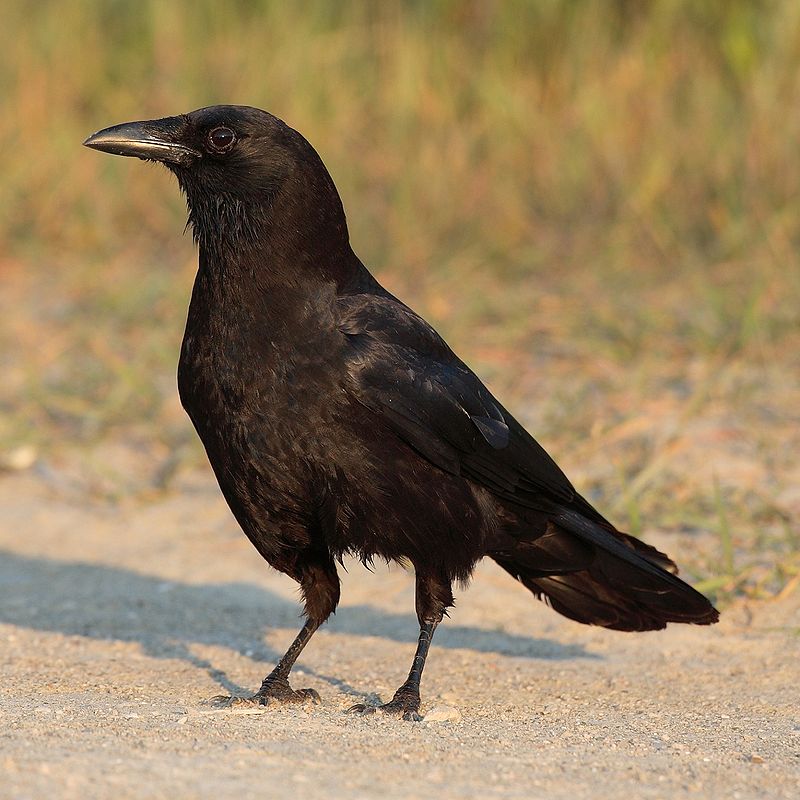
The American crow is a large bird of the Corvidae family, native to most parts of North America.
It is similar in size and structure to its European counterpart, the carrion crow and Eurasia’s hooded crow.
The three species occupy the same ecological niche but are distinguishable by their differences in appearance.
American crows have black feathers covering their entire body, with wingspans averaging between 17-21 inches wide for males and 16-19 inches for females.
They feed on insects such as grasshoppers, beetles, and caterpillars; they also eat grains from fields or abandoned farms during winter when food sources become scarcer.
In addition to feeding habits, American crows can be identified by their distinct call, which resembles a “caw” sound that travels long distances over open terrain, making them popular among birdwatchers.
Scientific classification:
| Kingdom | Animalia |
| Phylum | Chordata |
| Class | Aves |
| Order | Passeriformes |
| Family | Corvidae |
| Genus | Corvus |
| Species | C. brachyrhynchos |
20. Red-bellied woodpecker
The Red-bellied woodpecker is a beautiful bird with an orange-red crown and nape. It breeds mainly in the eastern United States, from Florida to Canada.
This medium-sized woodpecker of the family Picidae has black wings, white stripes on its back, and tail feathers barred with black.
Its underside is primarily pale or white, but it also has coloration around its neck area.
Despite this subtle red hue, it should not be mistaken for the entirely red head and neck belonging to the Red-headed woodpecker of the same genus, Melanerpes carolinus.
The Red-bellied Woodpeckers’ diet consists primarily of insects such as ants, beetles, grasshoppers, wild fruits, berries, and tree sap, which they feed upon at different times throughout their life cycle.
Scientific classification:
| Kingdom | Animalia |
| Phylum | Chordata |
| Class | Aves |
| Order | Piciformes |
| Family | Picidae |
| Genus | Melanerpes |
| Species | M. carolinus |
21. Gray Catbird
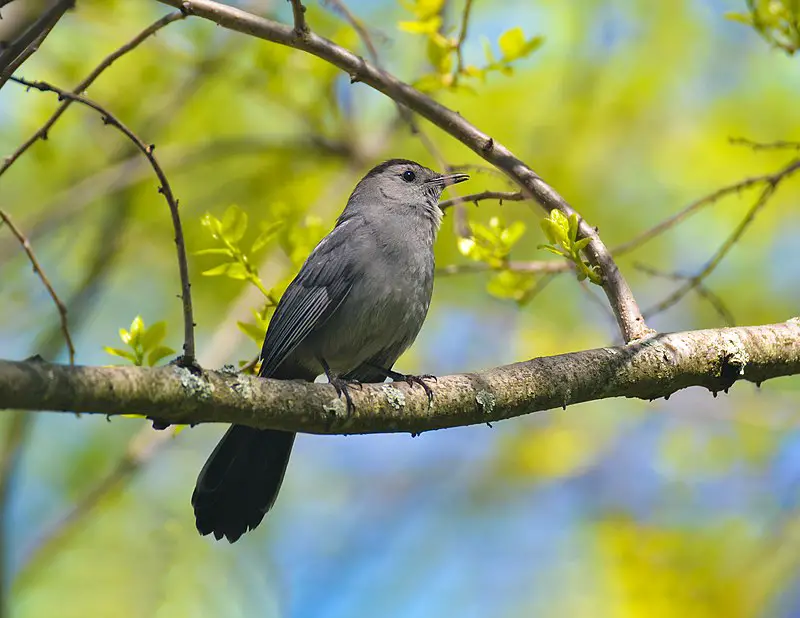
The Gray Catbird is a medium-sized bird native to North and Central America. It is the only species in its genus, Dumetella, which makes it unique among other perching birds of the Mimidae family.
Its plumage features shades of gray with some brownish tones on top and lighter grey below.
The underside of its tail has white feathers that contrast against its otherwise monochromatic coloration; this feature gives them traits as they flicker their tail, alarmed or excited like cats do.
They are omnivorous but feed on insects such as caterpillars, grasshoppers, and beetles while eating fruits like berries or cherries during summer.
Despite being commonly seen alone or in pairs, these birds will often flock together for protection from predators like hawks drawn to their dark-colored green foliage, making them more challenging to spot.
Scientific classification:
| Kingdom | Animalia |
| Phylum | Chordata |
| Class | Aves |
| Order | Passeriformes |
| Family | Mimidae |
| Genus | Dumetella C.T. Wood, 1837 |
| Species | D. carolinensis |
22. Brown-Headed Cowbird
The Brown-headed Cowbird is a small, obligate brood parasitic icterid native to temperate and subtropical North America. It has a brown head with glossy black plumage on the body, wings, and tail feathers.
During summer, it can be found in prairies, grasslands, and open wooded areas, but during winter, it migrates southwards towards the United States of Mexico for warmer climates.
They are mainly insectivorous birds that eat insects like caterpillars or beetles and consume some grains.
The female bird lays its eggs in nests of other species that tinc update them until hatching time, thus leaving their cs uncared for by themselves.
Scientific classification:
| Kingdom | Animalia |
| Phylum | Chordata |
| Class | Aves |
| Order | Passeriformes |
| Family | Icteridae |
| Genus | Molothrus |
| Species | M. ater |
23. Carolina Wren
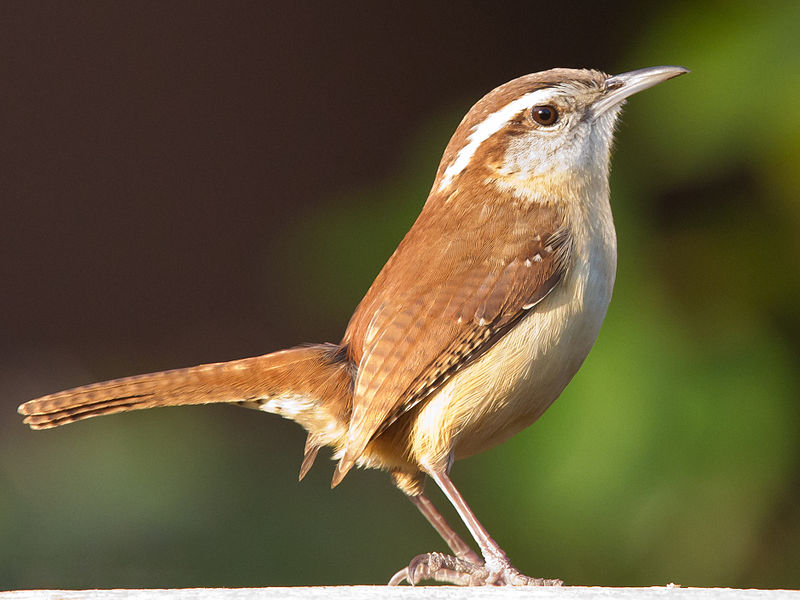
The Carolina wren (Thryothorus ludovicianus) is a medium-sized bird in the eastern United States, southern Ontario, and northeast Mexico.
They typically live in dense shrubbery or thickets near open areas such as gardens, parks, and woodland edges.
These birds are comfortable regarding nesting sites – they will build their nests anywhere from tree cavities to manmaartificials.
Their diet consists of insects, spiders, and other invertebrates, which they forage for on the ground or among vegetation.
The males have an unmistakable song of loud whistles interspersed with trills reminiscent of laughter; you’ll often find these cheerful little birds singing away during the early morning hours.
Scientific classification:
| Kingdom | Animalia |
| Phylum | Chordata |
| Class | Aves |
| Order | Passeriformes |
| Family | Troglodytidae |
| Genus | Thryothorus Vieillot, 1816[2] |
| Species | T. ludovicianus |
24. White-Throated Sparrow
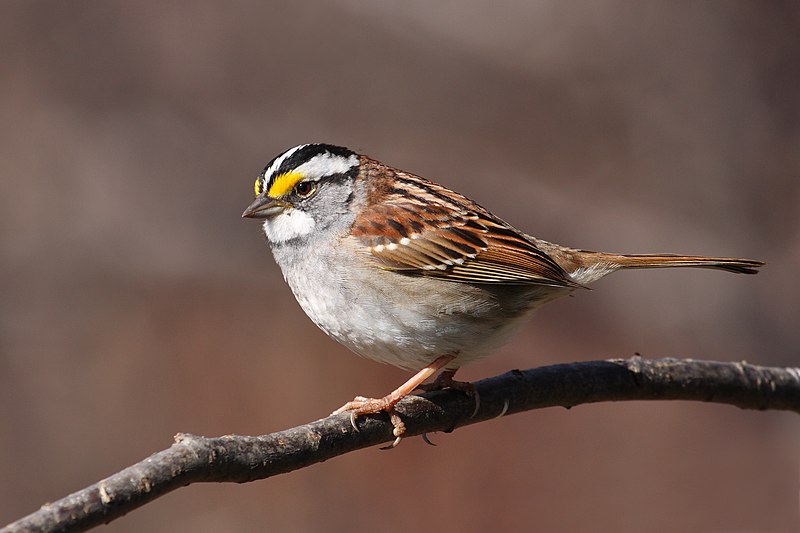
The White-throated Sparrow is a small passerine bird of the New World sparrow family Pass,erellidae.
It has distinctive yellow and black stripes on its head, white throat and chest, grey back, wings, and light brown legs.
The scientific name “Zonotrichia albicollis” comes from Ancient Greek for ‘band’ (ζώνη), ring to its distinctive striped crown, and Latin for ‘white neck’ (albus collum).
These birds are usually found in wooded areas such as coniferous forests or deciduous habitats in North America, where they feed mainly on insects during the summer months, switching to seeds during winter.
They build their nests near ground level using grasses, twi, gs, or m,oss, lined with feathers.
White-throated Sparrows may be solitary but also form flocks when migrating southward each fall season, typically occurring over mid-late October through November deep, depending on location within range.
Scientific classification:
| Kingdom | Animalia |
| Phylum | Chordata |
| Class | Aves |
| Order | Passeriformes |
| Family | Passerellidae |
| Genus | Zonotrichia |
| Species | Z. albicollis |
25. Chipping Sparrow
The Chipping Sparrow is a small passerine bird in most of North America. It has two subspecies, the eastern and western chipping sparrows, which migrate seasonally to overwinter in warmer climates.
The birds are grey above with white underparts, have a rufous cap with black stripes, and large eyes surrounded by light brown feathers.
They feed mainly on seeds but can also be seen eating insects during breeding season when raising their young chicks.
These intrebravelerufravelein open grasslands, such as prairies or meadows, where they build nests in trees or shrubs to raise their young family.
Their cheerful song often sounds like ‘chips, hence its name: Chi: ping Sparrow.
Scientific classification:
| Kingdom | Animalia |
| Phylum | Chordata |
| Class | Aves |
| Order | Passeriformes |
| Family | Passerellidae |
| Genus | Spizella |
| Species | S. passerina |
26. Cooper’s Hawk
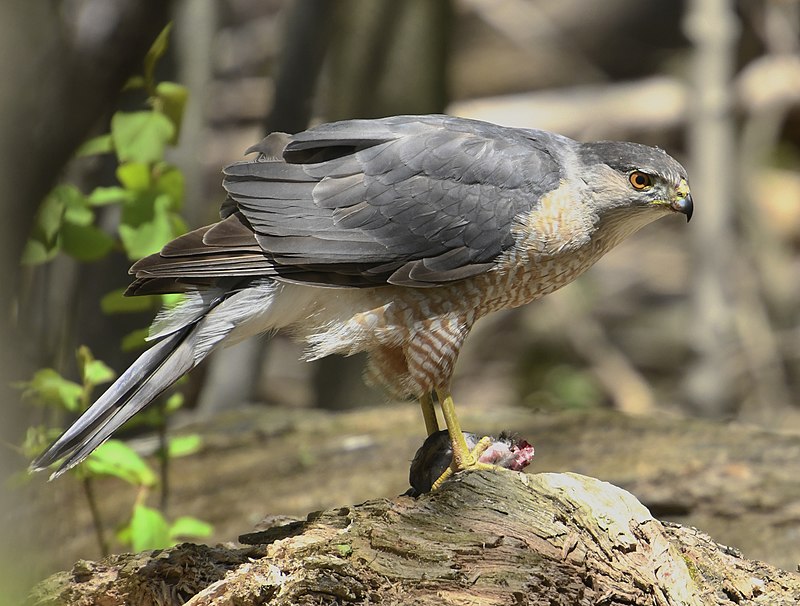
Cooper’s Hawk is a medium-sized bird of prey native to North America. It belongs to the Accipiter genus and is known for its tiny compared to other hawks.
They usually inhabit wooded areas, making them well-adapted hunters in dense environments.
Cooper’s Hawks have rounded wings with short tails that help them maneuver quickly through trees when chasing prey such as small rodents or birds.
These raptors also possess powerful feet equipped with sharp talons to catch food items on the ground and even out of midair.
The adult plumage has barred upperparts, ranging from greyish brown on lighter individuals to dark chestnut colors found in darker specimens; they also display rusty underparts marked by thin white streaking down either side of their chests and bellies.
Scientific classification:
| Kingdom | Animalia |
| Phylum | Chordata |
| Class | Aves |
| Order | Accipitriformes |
| Family | Accipitridae |
| Genus | Accipiter |
| Species | A. cooperii |
27. Ruby-Throated Hummingbird
The ruby-throated hummingbird (Archilochus colubris) is a hummingbird species with an impressive migration pattern, spending the winter in Central America, Mexico, and Florida before flying to Canada and other parts of Eastern North America for the breeding season.
It’s the most common type seen east of the Mississippi River in North America.
Formally described by Swedish naturalist Carl Linnaeus in 1758, this tiny bird has bright metallic green upperparts with white underparts, a small black bill, and a red throat patch, which gives it its name; they measure around 3 inches long on average.
They feed primarily on nectar from flowers but eat insects such as flies or mosquitoes for extra protein during their migrations or when raising young chicks.
Scientific classification:
| Kingdom | Animalia |
| Phylum | Chordata |
| Class | Aves |
| Order | Apodiformes |
| Family | Trochilidae |
| Genus | Archilochus |
| Species | A. colubris |
28. Northern Goshawk
The Northern Goshawk is a medium-large bird of prey belonging to the Accipitridae family. It has been known as one of the true hawks, with “Accipiter” meaning Hawk in Latin and “gentigentileserring to its noble characteristics.
They are found worldwide, most commonly in wooded areas such as forests or thickets, where they hunt small birds and mammals.
The males have spotted grey upperparts, while females tend to be fully entirely above with some lighter barring on their underparts.
These raptors rely heavily on speed and agility when hunting from either perches or during aerial dives at high speeds for their prey, which makes them formidable predators that can reach up to 40 mph.
Scientific classification:
| Kingdom | Animalia |
| Phylum | Chordata |
| Class | Aves |
| Order | Accipitriformes |
| Family | Accipitridae |
| Genus | Accipiter |
| Species | A. gentilis |
29. Eastern Phoebe
The Eastern Phoebe is a small passerine bird belonging to the genus Sayornis. It comes from Charles Lucien Bonaparte’s Muscicapa, and ancient Greek ornis means “bird.”
The species’ alternative name ‘Phoebe’ comes from the Roman moon-moon goddess but has also been said to imitate their call.
They are up to 16 cm long with a 25–30 cm wingspan, they have grayish brown upperparts and pale underparts.
They are found near streams, woodlands, and open fields where they hunt for insects such as flies, bees, wasps,s, etc., often catching them midair or by sallying out from perch perches, branches, or fences.
These birds make shallow cup nests of grasses lined with mud-built on cliffs, ledges, buildings, bridges, trees, etc.
All in all, a beautiful little bird is an exciting sight wherever you find it.
Scientific classification:
| Kingdom | Animalia |
| Phylum | Chordata |
| Class | Aves |
| Order | Passeriformes |
| Family | Tyrannidae |
| Genus | Sayornis |
| Species | S. phoebe |
30. Sharp-Shinned Hawk
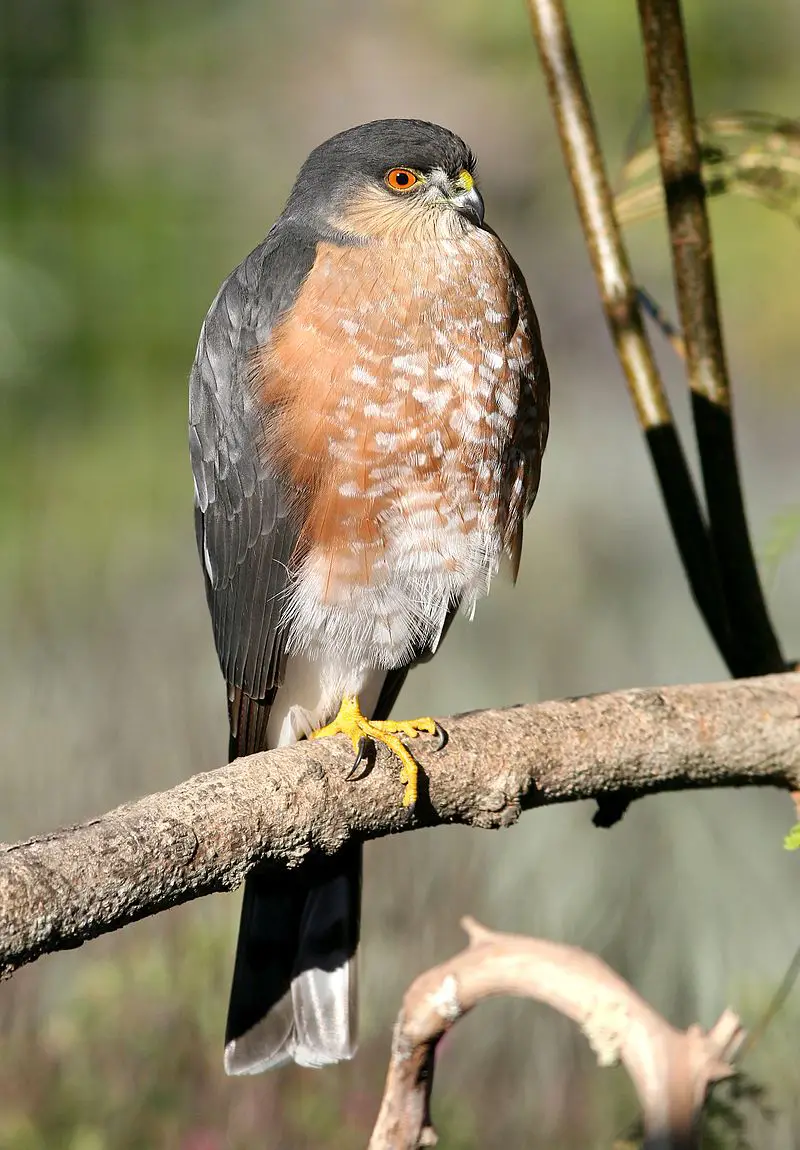
The Sharp-shinned Hawk is a small hawk found throughout the United States and Canada. It is one of the smallest hawks in North America but more significant than some Neotropical species, such as the tiny hawks.
TaxonThe taxonomy of his bird remains uncertain; wit, some authorities suggest that southern taxa may represent three distinct species: white-breasted Hawk (A. chionogaster), plain-breasted hawk (A. ventralis), and rufous morph sharp sharp-shinned hawk unicentric).
These birds feed primarily on small birds like finches, sparrows, woodpeckers, and warblers while hunting from perches or flying through dense vegetation to surprise unsuspecting prey items.
They are agile flyers that rely heavily on surprise to quickly capture food items before they can fly away.
Scientific classification:
| Kingdom | Animalia |
| Phylum | Chordata |
| Class | Aves |
| Order | Accipitriformes |
| Family | Accipitridae |
| Genus | Accipiter |
| Species | A. striatus |
31. American Tree Sparrow
The American tree sparrow, also known as the winter sparrow, is a medium-sized New World bird. It has an attractive rusty cap, grey underparts, and a small dark spot on its chest.
Its back is rust-colored striped with lighter shades of brown, while its wings have various shades of brown.
These birds are usually found in open areas such as grasslands or marsh marshlands during spring migration and can form large flocks when seeking food sources like seeds, insects, or berries.
They nest in shrubs or trees near water sources but rarely do so far away from human settlements due to their dependence on supplementary foods provided by humans.
The American Tree Sparrow is a delightful sight for any nature enthusiast.
Scientific classification:
| Kingdom | Animalia |
| Phylum | Chordata |
| Class | Aves |
| Order | Passeriformes |
| Family | Passerellidae |
| Genus | Spizelloides Slager & Klicka, 2014 |
| Species | S. arborea |
32. Peregrine Falcon
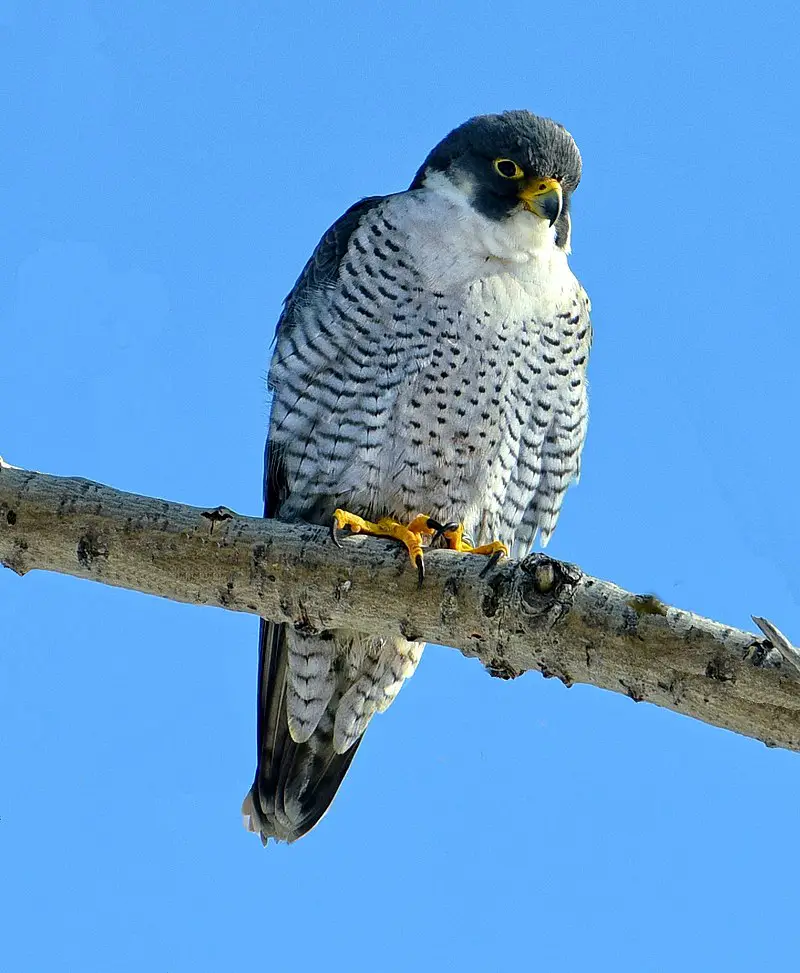
The Peregrine Falcon is a majestic bird of prey belonging to the family Falconidae. It has a blue-grey back, barred white underparts, and a black head maki, ng it easily recognizable.
This intelligent raptor is known for its incredible speed reach,hing over 320 km/h (200 mph) during hunting dives – one of the fastest animals.
The peregrine falcon can be found worldwide, from Arctic tundra to tropical rainforests, thriving with humans or in high alpine mountains far from civilization.
Their beauty, power, and adaptability make them an impressive species that have earned respect among many cultures throughout history as symbols of strength and endurance.
Scientific classification:
| Kingdom | Animalia |
| Phylum | Chordata |
| Class | Aves |
| Order | Falconiformes |
| Family | Falconidae |
| Genus | Falco |
| Species | F. peregrinus |
33. American Yellow Warbler
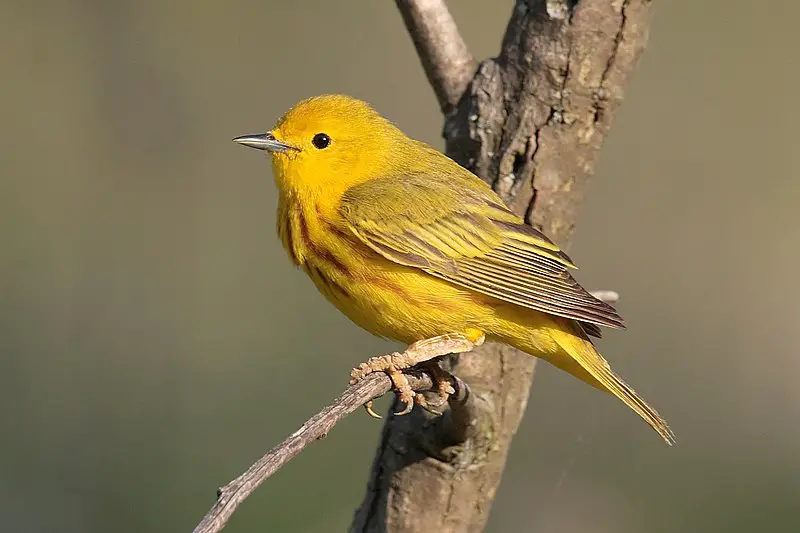
The American Yellow Warbler (Setophaga petechia) is a species of New World warbler found across North America, the Caribbean, and northern South America.
Its genus name is Seto, phage, from Ancient Greek words meaning “moth” and “eating,” while its specific name, Pete, chia Orig, is in Italian for tiny red spots.
This bird has striking yellow plumage with reddish-brown streaks on their chest that can be seen during mating season when they are most colorful.
They live in open woodlands near wetlands or bodies of water where they can find food, such as insects like spiders, beetles, and caterpillars, which comprise much of their diet.
The male will sing to attract a mate during the breeding season before setting up a home in twig nests built by both sexes together high in trees or shrubs.
Scientific classification:
| Kingdom | Animalia |
| Phylum | Chordata |
| Class | Aves |
| Order | Passeriformes |
| Family | Parulidae |
| Genus | Setophaga |
| Species | S. petechia |
34. Canada Goose
The Canada goose is a majestic bird with a black head and neck, white cheeks, chin, and brown body. It’s native to North America but occasionally migrates to northern Europe across the Atlantic.
The species has also been introduced in the United Kingdom, Ireland, and Finland. Canada geese are strong flyers that travel in flocks for protection from predators and form monogamous pairs for life.
They feed on grasses or grains near ponds or wetlands where they make their nests of down, which they incubate eggs during the summer before hatching them into goslings later on.
Scientific classification:
| Kingdom | Animalia |
| Phylum | Chordata |
| Class | Aves |
| Order | Anseriformes |
| Family | Anatidae |
| Genus | Branta |
| Species | B. canadensis |
35. Turkey Vulture
The turkey vulture is a large bird of prey in many parts of the world. It has a wingspan of up to 6 feet, and its feathers are primarily brownish-red patches on the underside, which give it an overall dark red appearance.
Its head is bald, which helps protect it from getting overheated when flying long distances looking for food.
The Turkey Vulture usually feeds off carrion but will also feed on fruit and insects.
Its keen eyesight allows them to spot potential meals from miles away while they soar through the sky using their broad wings and thermal air currents to stay aloft without expending much energy.
They are very important scavengers as they keep ecosystems healthy by consuming dead animals before disease can spread amongst living creatures or contaminate local water sources like rivers or lakes.
Scientific classification:
| Kingdom | Animalia |
| Phylum | Chordata |
| Class | Aves |
| Order | Accipitriformes |
| Family | Cathartidae |
| Genus | Cathartes |
| Species | C. aura |
36. Red-Tailed Hawk
The Red-tailed Hawk is a majestic bird of prey with a distinctive red tail. It can be found throughout North America, from Alaska in the north to Panama and the West Indies in the south.
This species belongs to the Buteothe genus, making it one of the most common raptors on Earth.
These hawks mainly hunt small mammals such as rabbits or squirrels but also feed on reptiles and birds during migration season.
Unlike other predator birds, they prefer open areas for hunting, like fields or grasslands, rather than dense forests.
They build their nests high on trees, staying all year long unless humans or animals nearby disturb them.
Their presence has become an iconic part of American culture due to their frequent sightings around homes and parks alike, making them beloved creatures among people everywhere.
Scientific classification:
| Kingdom | Animalia |
| Phylum | Chordata |
| Class | Aves |
| Order | Accipitriformes |
| Family | Accipitridae |
| Genus | Buteo |
| Species | B. jamaicensis |
37. New World Warblers
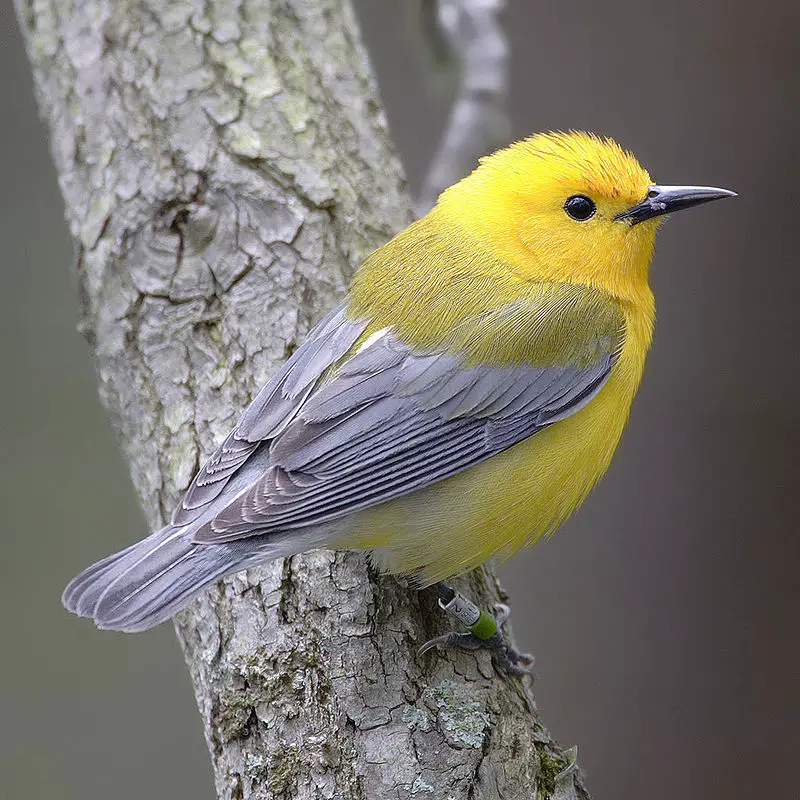
New World warblers are an incredibly diverse family of small birds found only in the Americas. They range in size from tiny hummingbirds to large thrushes and come in various vibrant colors.
All have thin bills for eating insects, which form their main primary. Most species live predominantly arboreal lives, meaning they spend most of their time among trees or bushes searching for food.
However, some members, such as ovenbirds and waterthrushes, prefer more terrestrial habitats like forest floors where they can scavenge for bugs on the ground instead.
Warblers provide a great source of entertainment with their beautiful songs, often filling up woodlands during mornings and evenings throughout springtime.
Scientific classification:
| Kingdom | Animalia |
| Phylum | Chordata |
| Class | Aves |
| Order | Passeriformes |
| Superfamily | Emberizoidea |
| Family | Parulidae Wetmore et al., 1947 |
38. Eastern Kingbird
The Eastern kingbird is an impressive large grey bird with a white underbelly and pointed wings. It can be seen perched atop trees or bushes in open areas while foraging for insects.
This species of tyrant flycatcher breeds across much of North America during the spring and summer months before migrating southwards come wintertime.
During this time, they have been known to travel as far south as Central and South America.
These birds are particularly territorial when nesting; they have been observed chasing off even larger animals as hawks are away from their nests. A truly remarkable sight to behold.
Scientific classification:
| Kingdom | Animalia |
| Phylum | Chordata |
| Class | Aves |
| Order | Passeriformes |
| Family | Tyrannidae |
| Genus | Tyrannus |
| Species | T. tyrannus |
39. Pine Warbler
The Pine Warbler is a small New World bird with olive-brown upper parts and a white belly.
Its distinguishing features include two white wing bars, dark legs, thin pointed bills, and yellowish ‘spectacles’ around its eyes.
Adult males have bright yellow throats and breasts on top of their olive upper part sales, and immatures are less vibrant in coloucolorretain similar characteristics.
These birds can be found near pine forests throughout North America during the summer months before migrating to warmer climates for winter.
They feed mainly on insects such as caterpillars, spiders, and flies while consuming fruits like blueberries when food becomes scarce in colder times of the year.
These tiny songbirds provide us with much beauty through their unique plumage patterns while being essential within their ecosystems.
Scientific classification:
| Kingdom | Animalia |
| Phylum | Chordata |
| Class | Aves |
| Order | Passeriformes |
| Family | Parulidae |
| Genus | Setophaga |
| Species | S. pinus |
40. Barred Owl
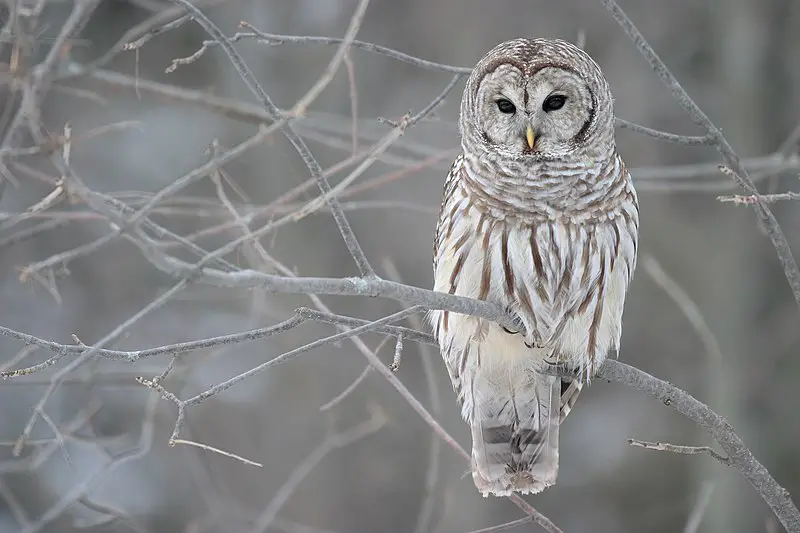
The Barred Owl is a large species of owl native to eastern North America. It belongs to the genus Strix, part of the true owl family Strigidae.
These beautiful birds are mainly brown with distinct stripes on their bodies and wings. Its face has dark eyes, a white chin patch, and two black bars across its yellow-brownish beak, giving it an intimidating appearance.
The barred owls have powerful talon nails for hunting small mammals like mice and voles and other animals such as fish, amphibians, or insects.
They also rely heavily on hearing when looking for prey in low-low-light conditions.
With their exceptional abilities, these birds can often remain undetected while observing potential threats from predators, making them highly successful hunters.
Scientific classification:
| Kingdom | Animalia |
| Phylum | Chordata |
| Class | Aves |
| Order | Strigiformes |
| Family | Strigidae |
| Genus | Strix |
| Species | S. varia |
41. American Woodcock
The American woodcock is a small shorebird found mainly in the eastern half of North America. It has brown, black, and grey plumage, which ideally helps it blend into its brushy, young-forest habitats.
Often referred to as the timberdoodle or bogsucker due to their quirky behavior, these birds generally spend their time foraging on the ground for food, like worms and insects.
During mating season, males perform an elaborate courtship ritual involving loud calls from atop tall perches and graceful dives toward the Earth while singing songs.
The female selects her mate based solely on performance during this ritual display.
Overall, this bird is truly amazing with its unique appearance and exciting behaviors that are pretty beautiful among anthropologists worldwide.
Scientific classification:
| Kingdom | Animalia |
| Phylum | Chordata |
| Class | Aves |
| Order | Charadriiformes |
| Family | Scolopacidae |
| Genus | Scolopax |
| Species | S. minor |
42. Snowy Owl
The Snowy Owl is an impressive bird of prey native to the North American and Palearctic Arctic regions.
It has a unique white plumage that helps it blend in with its snowy tundra habitat and several adaptations that make it suitable for life in cold climates.
These include thick feathers that protect their bodies from frigid temperatures, large eyes adapted for hunting during long winter nights, and talons designed for gripping slippery surfaces such as ice or snow.
This majestic owl will soar high above its territory, ching for food before gliding back down again to perch atop rocks or trees.
The Snowy Owl truly stands out amongst other birds of prey – an iconic symbol of the beauty and mystery of the north.
Scientific classification:
| Kingdom | Animalia |
| Phylum | Chordata |
| Class | Aves |
| Order | Strigiformes |
| Family | Strigidae |
| Genus | Bubo |
| Species | B. scandiacus |
43. Eastern Towhee
The Eastern Towhee is a large New World sparrow native to brushy areas of eastern North America. These birds have distinct black and white markings, with chestnut brown underparts.
They nest either low in bushes or on the ground beneath shrubs. Northern towhees are known for migrating south during the winter months.
In recent decades, taxonomy debates have left some questioning whether this bird should remain its species or be grouped with Spotted Towhee as one species — Rufous-sided Towhee.
This lively songbird is bubbly and can often hop around on branches looking for food, such as insects, fruits, and seeds.
Scientific classification:
| Kingdom | Animalia |
| Phylum | Chordata |
| Class | Aves |
| Order | Passeriformes |
| Family | Passerellidae |
| Genus | Pipilo |
| Species | P. erythrophthalmus |
44. Rough-Legged Buzzard
The Rough-legged Buzzard, also known as the Rough-legged Hawk, is a medium to large bird of prey that inhabits Arctic and Subarctic regions in North America, Europe, and Russia.
It migrates south during winter. These majestic birds build their nests on cliffs or other rocky ledges, making them rugged to spot from afar.
Depending on seasonality, their plumage can be either dark brown or light with barred underparts and a white head.
They have long wings, which help them cover incredible distances while migrating, but are by no means fast flyers – preferring soaring flight patterns where possible instead.
The primary diet for these raptors consists of small rodents such as voles and lemmings, which will take larger prey if needed (such as grouse).
Scientific classification:
| Kingdom | Animalia |
| Phylum | Chordata |
| Class | Aves |
| Order | Accipitriformes |
| Family | Accipitridae |
| Genus | Buteo |
| Species | B. lagopus |
Also Featured In Mos Common Romanian Birds, Birds of Norfolk
45. Broad-Winged Hawk
The Broad-winged Hawk is a medium-sized raptor of the Buteo genus. It has distinct subspecies distributed throughout eastern North America, ranging from British Columbia to Texas and migrating south during winter to places like Mexico and Brazil.
Other subspecies are year-round residents in the Caribbean Islands. Like most birds of prey, female Broad-winged Hawks tend to be larger than males – they can have up to 48 inches wingspans.
These hawks feed mainly on small mammals such as mice or voles but also eat insects, reptiles, and amphibians.
They nest high in trees, typically near open fields where food sources abound; their nests are often made with sticks lined with grasses or other materials for insulation purposes.
Scientific classification:
| Kingdom | Animalia |
| Phylum | Chordata |
| Class | Aves |
| Order | Accipitriformes |
| Family | Accipitridae |
| Genus | Buteo |
| Species | B. platypterus |
46. Mallard
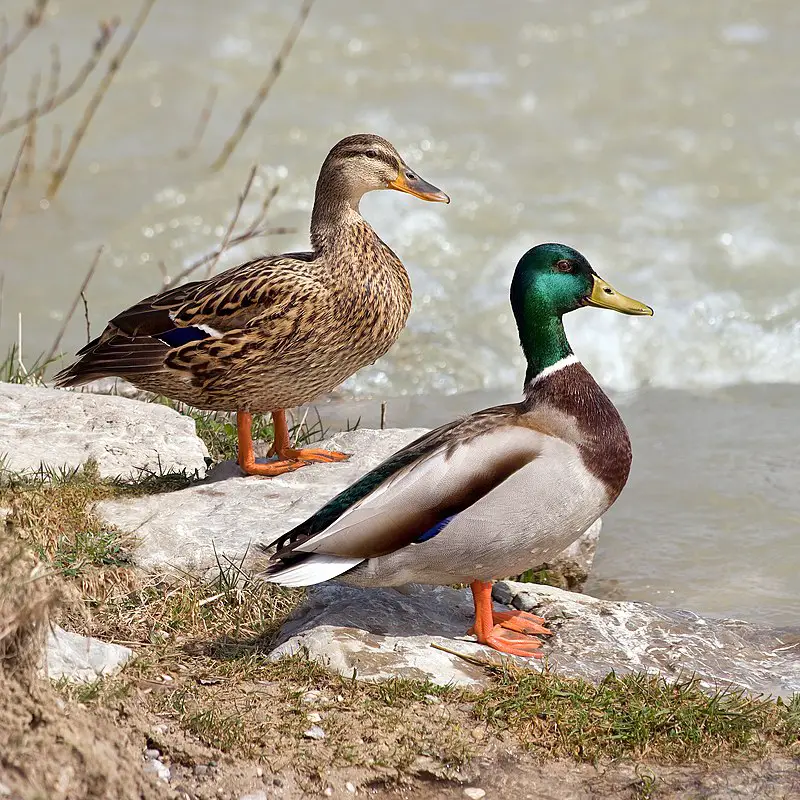
The Mallard is a species of dabbling duck that can be found living in temperate and subtropical regions across the Americas, Europe, and North Africa.
Humans have introduced it to other areas, such as New Zealand, Australia, Peru, Brazil, and South Africa,
This beautiful bird belongs to the Anatinae subfamily of waterfowl family Anatidae. The adult mallards have glossy green heads with white neck rings surrounding them.
It, and its brownish-grey body feathers, make them look stunning when they fly away or sit in their natural habitat around lakes or ponds.
They are excellent swimmers, too, due to webbed feet, which help them swim fast underwater while looking for food like aquatic insects, etc. Their loud quacking sound makes them quite popular among nature lovers.
Scientific classification:
| Kingdom | Animalia |
| Phylum | Chordata |
| Class | Aves |
| Order | Anseriformes |
| Family | Anatidae |
| Genus | Anas |
| Species | A. platyrhynchos |
47. Red-Breasted Nuthatch
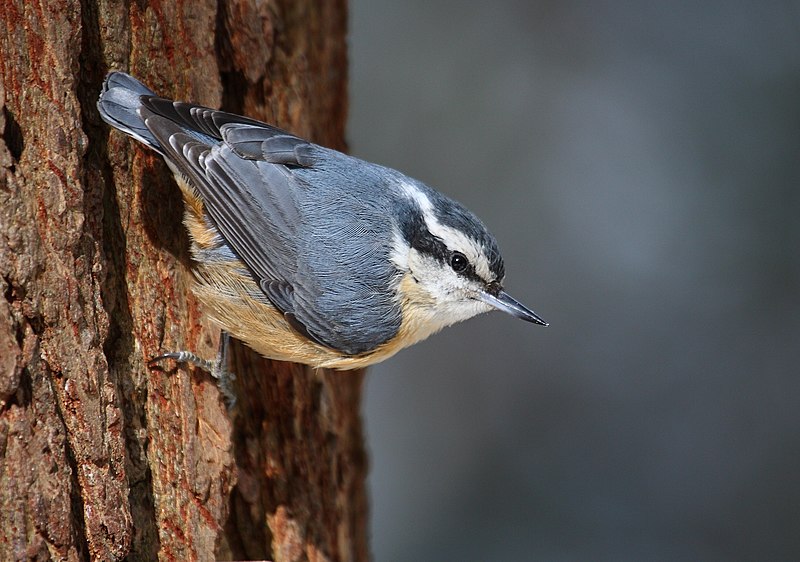
The Red-breasted Nuthatch is a beautiful and vocal songbird found in coniferous forests across Canada, Alaska, the northeastern United States, and the western US.
This small bird has blue-grey upper parts with cinnamon underparts, a white throat and face with black eye stripe, a solid light grey bill, and a black crown.
Its call sounds like a tin trumpet; it’s high-pitched yet nasal.
During mating season, they form monogamous pairs to build their nest near tree trunks or branches at low heights off the ground,d where they lay 2 – 8 eggs at once.
They are very active little birds who love clinging to trees while searching for insect larvae or seeds within the bark of trees, which helps control pest populations.
Scientific classification:
| Kingdom | Animalia |
| Phylum | Chordata |
| Class | Aves |
| Order | Passeriformes |
| Family | Sittidae |
| Genus | Sitta |
| Species | S. canadensis |
Conclusion
Exploring Massachusetts’ avian diversity reveals a tapestry of habitats supporting a rich array of birdlife.
Each species contributes to the state’s ecological tapestry, from the iconic American Robin to the majestic Red-tailed Hawk and the colorful warblers of spring.
Whether in urban areas or pristine wilderness, Massachusetts offers a vibrant birding experience for enthusiasts of all levels, inviting discovery and appreciation of its natural treasures.